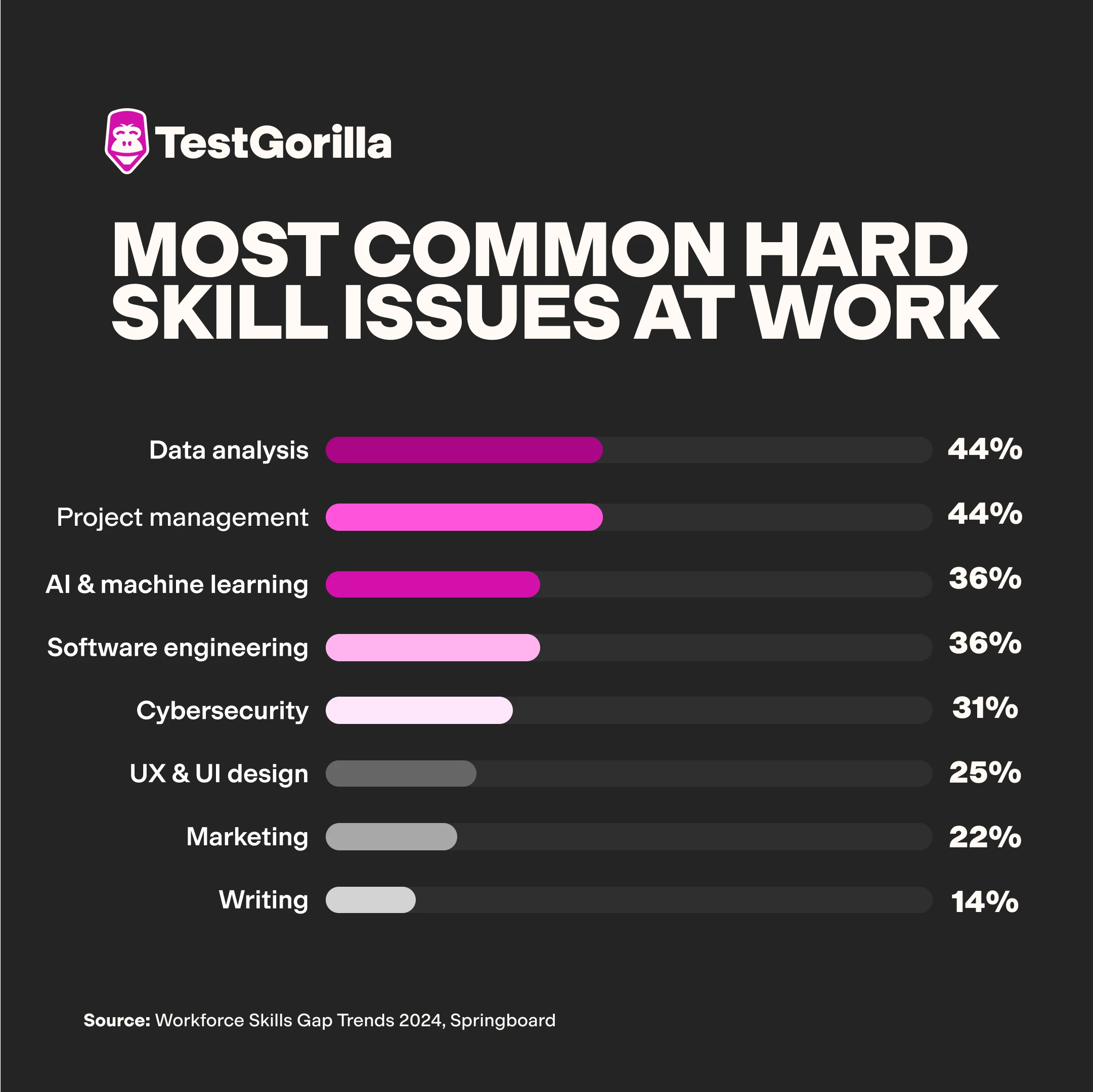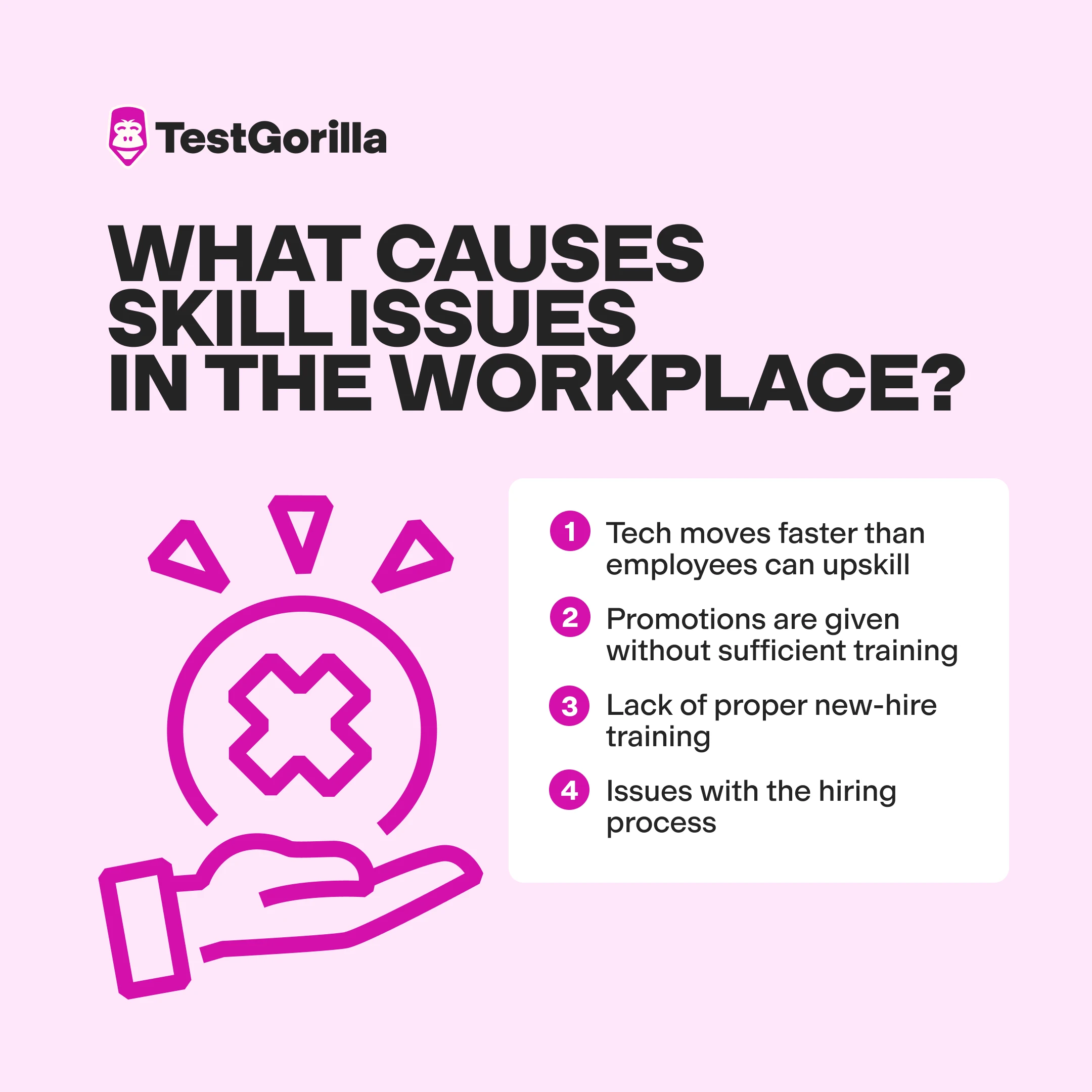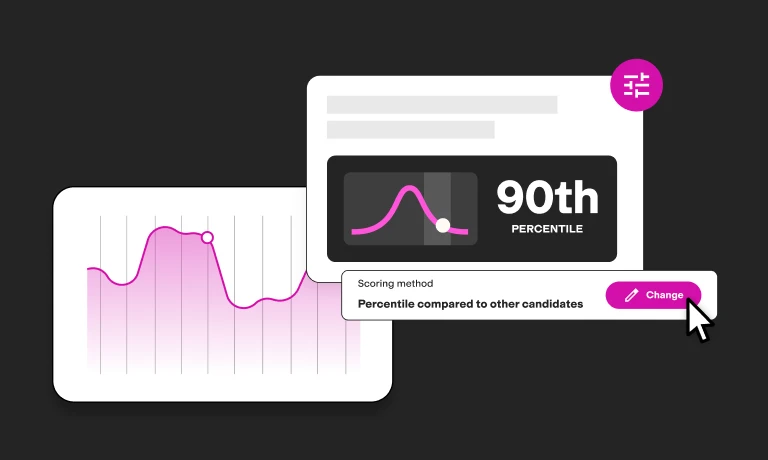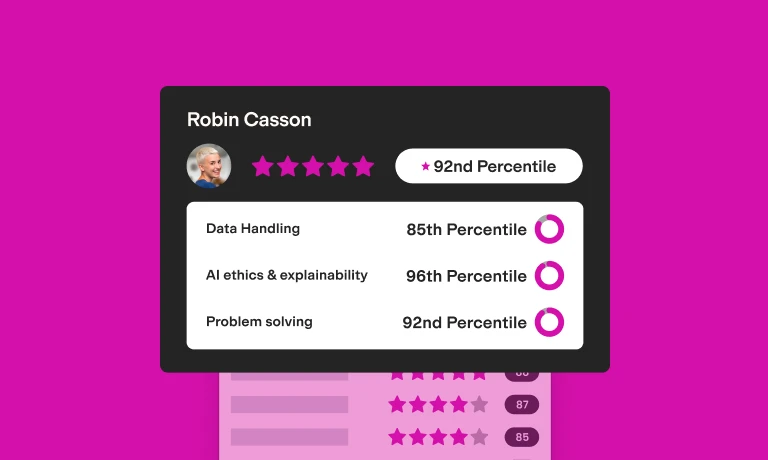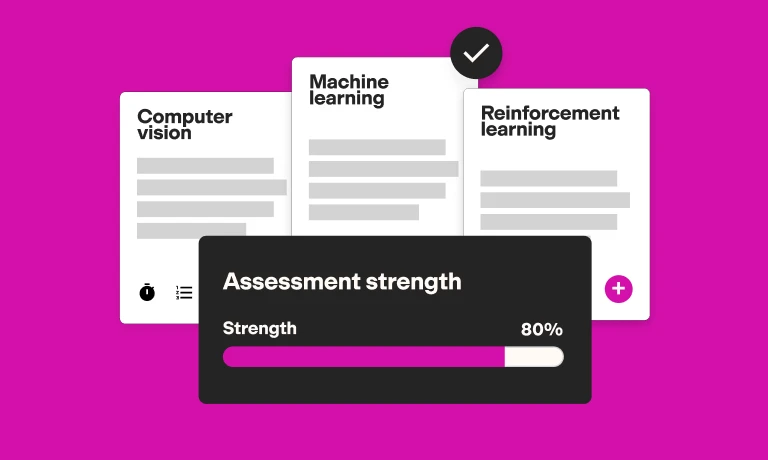At a time when business needs and technology are shifting at breakneck speed, skill issues are on the rise. A recent survey found that 70% of leaders reported skill issues in the workplace that are halting innovation and productivity. But what is a skill issue, and how can you identify, address and prevent them? Fear not – we’ve written this article to break down everything you need to know. You’ll learn the different types of skill issues, how to identify them with TestGorilla, and the best ways to address them.
What is a skill issue?
A skill issue, also known as a skill gap, is when there’s a mismatch between employee skills and job requirements or company needs. These issues often come to light as a result of a skills gap analysis.
It’s a complex problem that can be hard to pin down, but the effects of a significant skill issue can devastate business outcomes. Here are some sobering research findings from a survey of C-suite executives on the impact skill gaps had on their organizations:
More stress on employees (50%)
Longer project durations (43%)
Less able to meet business objectives (38%)
Less able to innovate (35%)
Heightened risk of security breaches (35%)
Higher operating costs (34%)
Increased hiring costs (30%)
Lost business to competitors (21%)
Lower customer satisfaction (21%)
Loss of revenue (20%)
But before you hide in the stationery closet and hope it blows over, remember you can follow proven steps to spot and solve skill issues before they get out of hand. Before taking action, though, you must look into the specific types of skill issues.
Different types of skill issues at work
Skill issues two main categories: hard skills and soft skills. Hard skill issues are usually plain to see, but soft skill issues can be trickier.
According to the Springboard Workforce Skills Gap Trends 2024 Report, these are the most common skill issues in both categories:
Hard skills
These are what most people think of when it comes to skills at work. Hard skills are usually capabilities that individuals have trained for or are specific technical skills.
According to respondents to Springboard’s survey, the most common hard skill issues are:
Data analysis (44%)
Project management (44%)
AI and machine learning (36%)
Software engineering (36%)
Cybersecurity (31%)
User experience (UX) and user interface (UI) design (25%)
Marketing (22%)
Writing (14%)
Soft skills
Soft skills are the interpersonal skills or cognitive abilities people apply to their work. They’re increasingly recognized as just as, if not more, important than hard skills. Per Springboard’s report, the most common soft skill issues are:
Strategic/critical thinking (57%)
Problem-solving and decision-making (49%)
Communication (46%)
Flexibility & adaptability (43%)
Emotional intelligence (40%)
Leadership (35%)
Time management (31%)
Creativity (30%)
Transferable skills
Sometimes, employees have the skills they need but struggle to transfer those skills into a new role. For example, say an employee with customer service experience is promoted to leadership. They may not realize it, but they’ve already developed communication skills they can use in their new position.
The best insights on HR and recruitment, delivered to your inbox.
Biweekly updates. No spam. Unsubscribe any time.
What causes skill issues in the workplace?
There are many causes for skill issues at work, but here are some of the most prevalent:
1. Tech moves faster than employees can upskill
AI, machine learning, and other technologies are constantly evolving, and keeping ahead of the curve requires continuous upskilling. But this isn’t always easy. If employees are already time-strapped, finding time to learn new tech can be challenging.
2. Promotions are given without sufficient training
Even the most capable employees need proper training when they’re promoted – especially to leadership positions. Competence in one role or one seniority level doesn’t always translate, and this is where training and development to overcome skill issues become essential.
3. Lack of proper new-hire training
Poor training of new hires is another major cause of skill issues at work. It happens when:
Training programs don’t evolve to meet job demands.
Employers assume new employees have skills that they don’t.
Training is rushed or skipped due to budget concerns.
Employers believe new hires will “pick it up as they go along.”
Not only does poor onboarding training directly lead to inadequate skill development, but it has also been linked to low engagement and higher turnover.
4. Issues with the hiring process
If your hiring process doesn’t adequately test for skills, you risk hiring people who don’t have the capabilities and qualities you need. Using talent assessments – like the ones TestGorilla offers – is a great way to ensure your new hires fit the bill.
We offer 400+ science-backed tests to assess hard and soft skills, including:
Job-specific skills
Personality traits
Behavioral preferences
Cognitive abilities
Situational judgment
All our tests undergo a rigorous quality assurance process before they’re published. You can combine up to five tests for a custom assessment and even add your own questions to tests.
How to identify skill issues
Suspect skill issues in your workplace? Here are proven methods for identifying them:
Employee surveys and feedback
Pinpointing the skills employees need to do their jobs is the first step toward solving the problem. Here are some ways to do this:
Ask directly. This may be a sensitive issue for your team members, so frame the question around the training they’d like to receive or the skills they could acquire to make their jobs easier.
Conduct anonymous self-assessment surveys. These are a great way to allow employees to evaluate their skills without fear of judgment.
Roll out 360-degree feedback surveys. These surveys gather feedback from an employee’s peers, supervisors, and subordinates for a full view of their skills.
Skill assessments
Skill assessments aren’t just for evaluating candidates. You can also use them to assess your current employees’ skills and spot gaps.
Platforms like TestGorilla are perfect for this. With our software, you can measure your team’s job-specific skills – from project management to telehealth and everything in between. You can then evaluate their soft skills, such as communication and business judgment, and personality traits (using any of our five personality tests).
How to address skill issues within your team
Now that you’ve identified where the skill issues lie, it’s time to address them. You can do this through:
Mentoring and coaching
Leaders adopting the role of coach and mentor is one of the major shifts we’ve seen in the workplace over the past 10 years. An effective leader is now increasingly seen as somebody who will motivate and work with employees to perform at their best. Here’s how you can mentor and coach your team to work on skill issues:
Provide regular constructive feedback.
Share your knowledge and experience, or put them in touch with someone with relevant knowledge and experience.
Keep an open door policy: encourage employees to ask for help when needed.
Regularly check in to see how they’re progressing.
Performance reviews and evaluations
After identifying skill gaps in an employee, address them in performance reviews to inspire action:
Offer positive feedback where appropriate. This will help cushion negative feedback and ensure the employee doesn’t leave feeling deflated.
Clarify that it’s a skill issue, not a talent issue. Keep the conversation focused on discussing how they can improve.
Discuss development plans. (More on this below!)
Provide assistance and support. Use this as an opportunity to establish yourself as a coach and mentor, making it clear that you’re there to help.
Avoid ultimatums. For example, don’t say that the employee will be fired if they don’t develop a skill within a certain time frame. This can cause a lot of anxiety.
Training and development programs
Enrolling your team in training and development programs is the most direct way to tackle skill issues. Below are some ideas of programs to consider. For soft skills:
One-day workshops for communication or leadership skills
Stress-management workshops
Cultural awareness training
Creativity or problem-solving workshops
For hard skills:
Technical certification programs
Cybersecurity awareness training
Machine learning and AI courses
Advanced degrees
These programs can either be online and self-directed, in-office, or conducted externally. If self-directed, allocate paid time for employees to focus on skill development.
Evaluating the success of skill development initiatives
Lastly, you need to ensure your skill development initiatives are effective. To do this, follow the checklist below.
Define your success metrics. These could include client feedback or the time taken to execute certain tasks.
Measure performance improvement. Track changes that can be traced back to your skill development plan. For instance, are employees completing tasks faster and with fewer errors?
Test employees before and after training. This way, you can see exactly how their skills have developed.
Measure business impact. If possible, examine the tangible benefits on team or company performance. Has productivity or client satisfaction increased since beginning the training?
Gather feedback. Ask your employees if they found training useful or their supervisors if their performance has improved.
Spot and solve skill issues with TestGorilla
Skill issues can cause significant issues, but they don’t need to be fatal. If HR and leadership are proactive in identifying and resolving skill issues and including accurate skill testing in the hiring process, your skill issues could be a thing of the past.
Want to know where to start? TestGorilla helps you resolve skill issues without the guesswork. Use our platform to hire people with the right skills and identify skill gaps in your current employees. Whether you’re experiencing hard or soft skill issues, we can help!
Get started with TestGorilla by checking out our test library or subscribing to our free plan today.
FAQ
What is the impact of mentorship on skill issues?
Whether it’s part of the company culture or you have formal mentorship programs, mentorship can help reduce skill issues. The mentor-mentee relationship provides a safe space for employees to discuss where they feel they’re lacking. From there, mentors can offer guidance on how to address the skill issue.
How does a skill issue affect employees?
Employees often bear the brunt of skill issues in the workplace – whether the issues lie with themselves or others. It can lead to:
Stress and overwhelm
Lower job satisfaction
More errors
Decreased confidence
Higher workloads
Increased risk of burnout
Higher dependency on colleagues
Resentment and conflict
Can outsourcing help with skill shortages?
Yes, but it may come at a cost. Outsourcing to address internal skill shortages can be a band-aid solution. It may be more costly in the long term and may not address the key issue. If you’re outsourcing to address skill issues that your internal team should be able to handle, this approach may not be sustainable. In such cases, it’s best to develop your internal workforce.
You've scrolled this far
Why not try TestGorilla for free, and see what happens when you put skills first.


